Refer to the given diagram. Match the labelled parts (A-J) with their functions and select the correct options.
(i)Carries nerve signals to the brain
(ii)Regulates the size of the pupil to let more or less light into the eye
(iii)Changes the shape of the lens
(iv)Photoreceptors are concentrated at this point
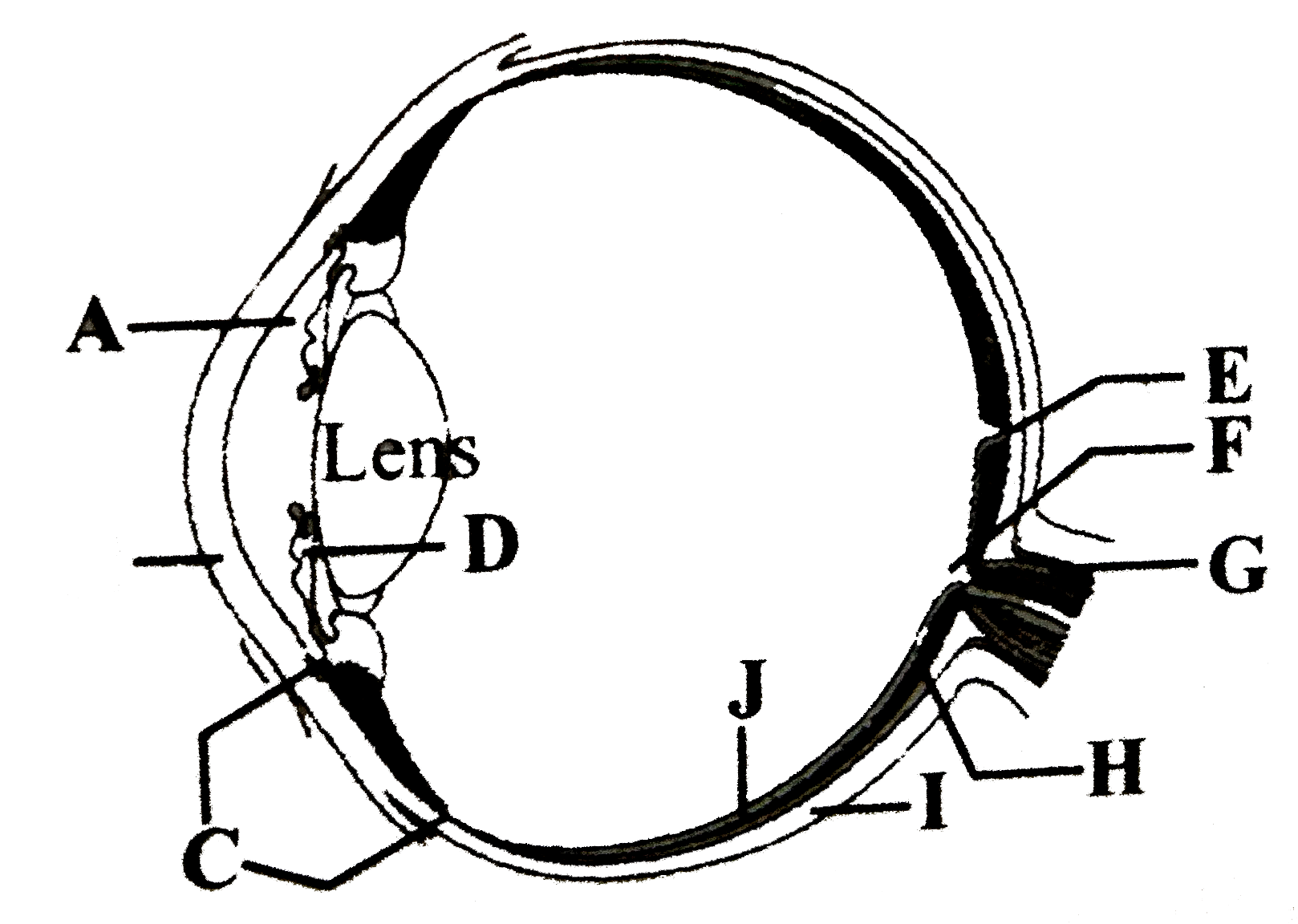
(i)-B, (ii)-D, (iii)-F, (iv)-H
(i)-J, (ii)-G, (iii)-I, (iv)-C
(i)-A, (ii)-C, (iii)-E, (iv)-G
(i)-G, (ii)-D, (iii)-C, (iv)-E
The correct Answer is:B
G' is optic nerve, 'D' is iris, 'C' is ciliary body, 'E' is fovea centralis.
Topper's Solved these Questions
Similar Questions
Match the parts of the brain given in column I with the function performed by then given in column II and select the correct option from the codes given below.
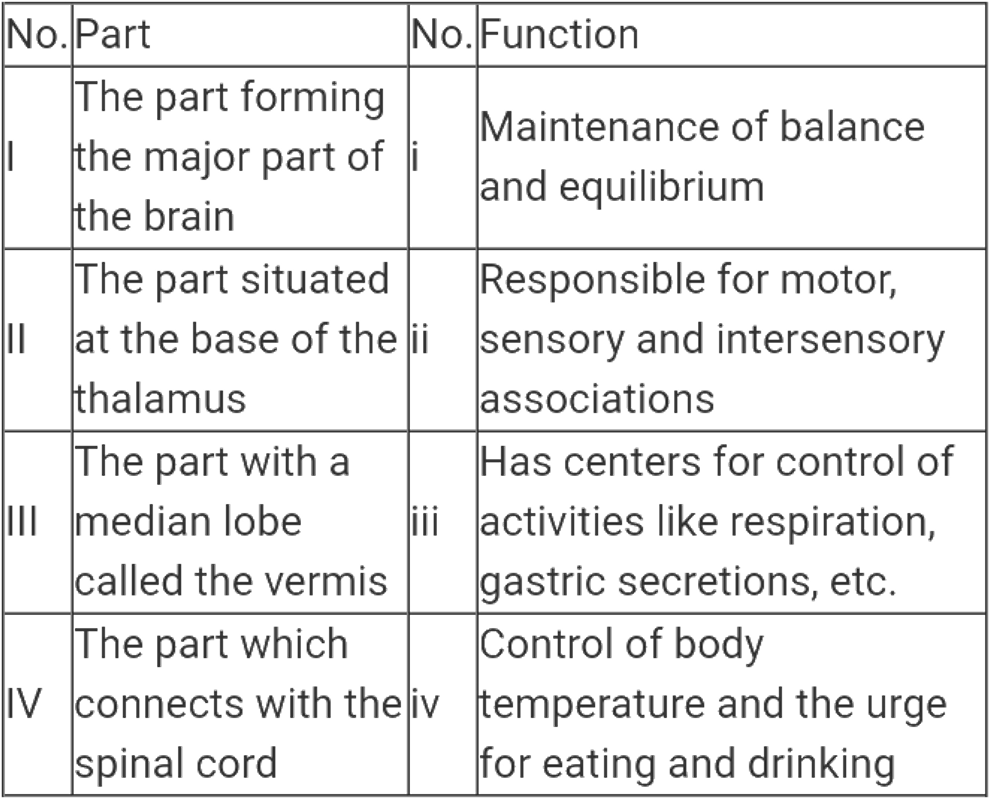 View Solution
View SolutionIdentify the functions/characteristics of parts labelled as A, B, C, D and E in the given diagram. Select the correct option after referring to the given table.
 View Solution
View Solution
Knowledge Check
- Question 1 - Select One
Study the following figure
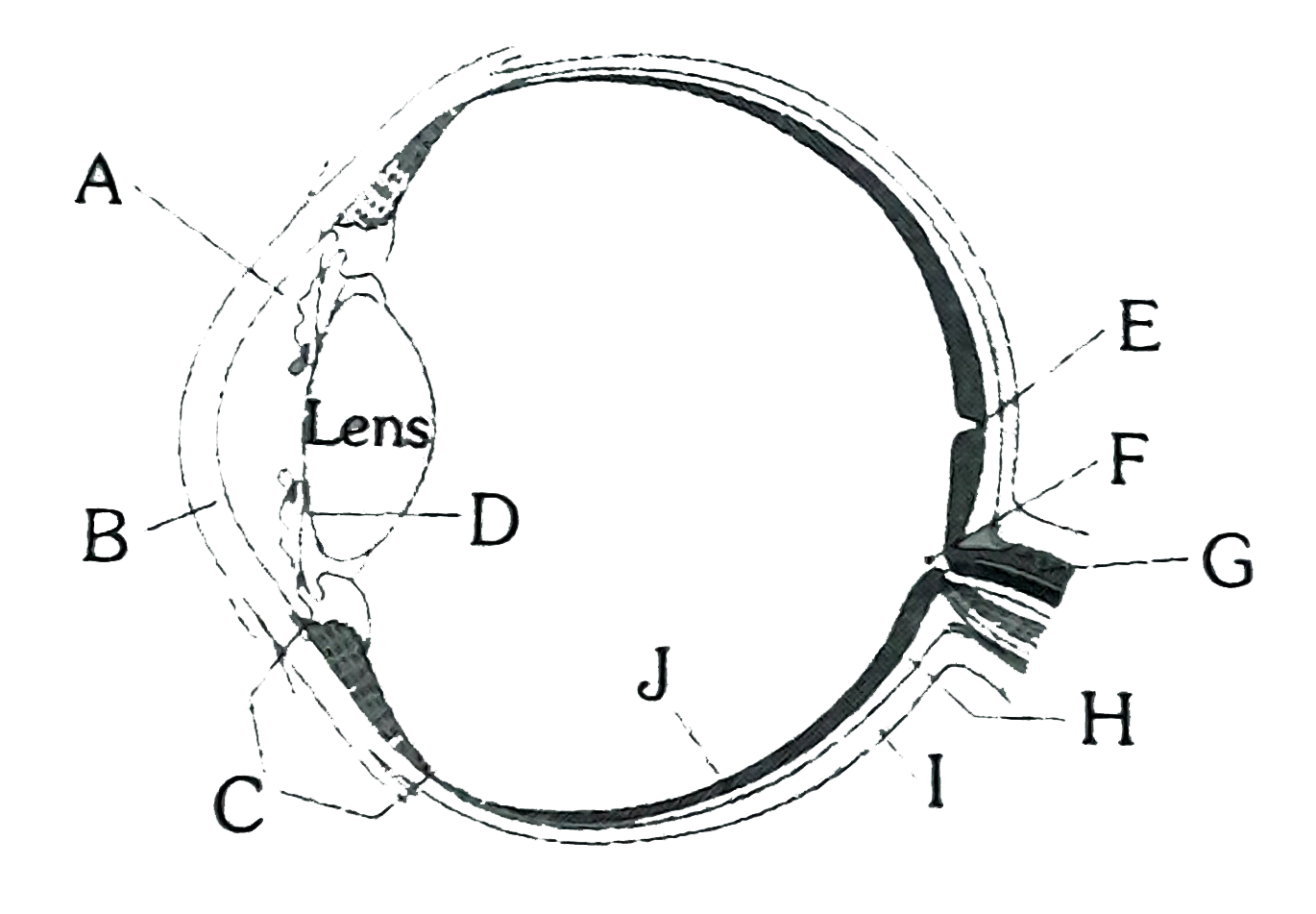
I. Carries nerve signal to the brain
II. Regulates the size of the pupil to let more or less light into the eye
III. CHange the shape of the lens
IV. Photoreceptors are highly concentrates at this center of focus
The correct match of the above functions with parts of the eye indicated by letters isAI-G, II-D, III-C, IV-EBI-A, II-C, III-E, IV-GCI-J, II-G, III-F, IV-CDI-B, II-D, III-F, IV-H - Question 2 - Select One
Following is the figure of a saggital section of a human brain.Match the labelled parts with the respective statements given below and select the correct option.
(i)Consists of fibre tracts that interconnect left and right hemispheres
(ii)Secretes a hormone melatonin
(iii)Alcohol interferes with the function of this part
(iv)Contains centres which control respiration , cardiovascular reflexes and gastric secretions.
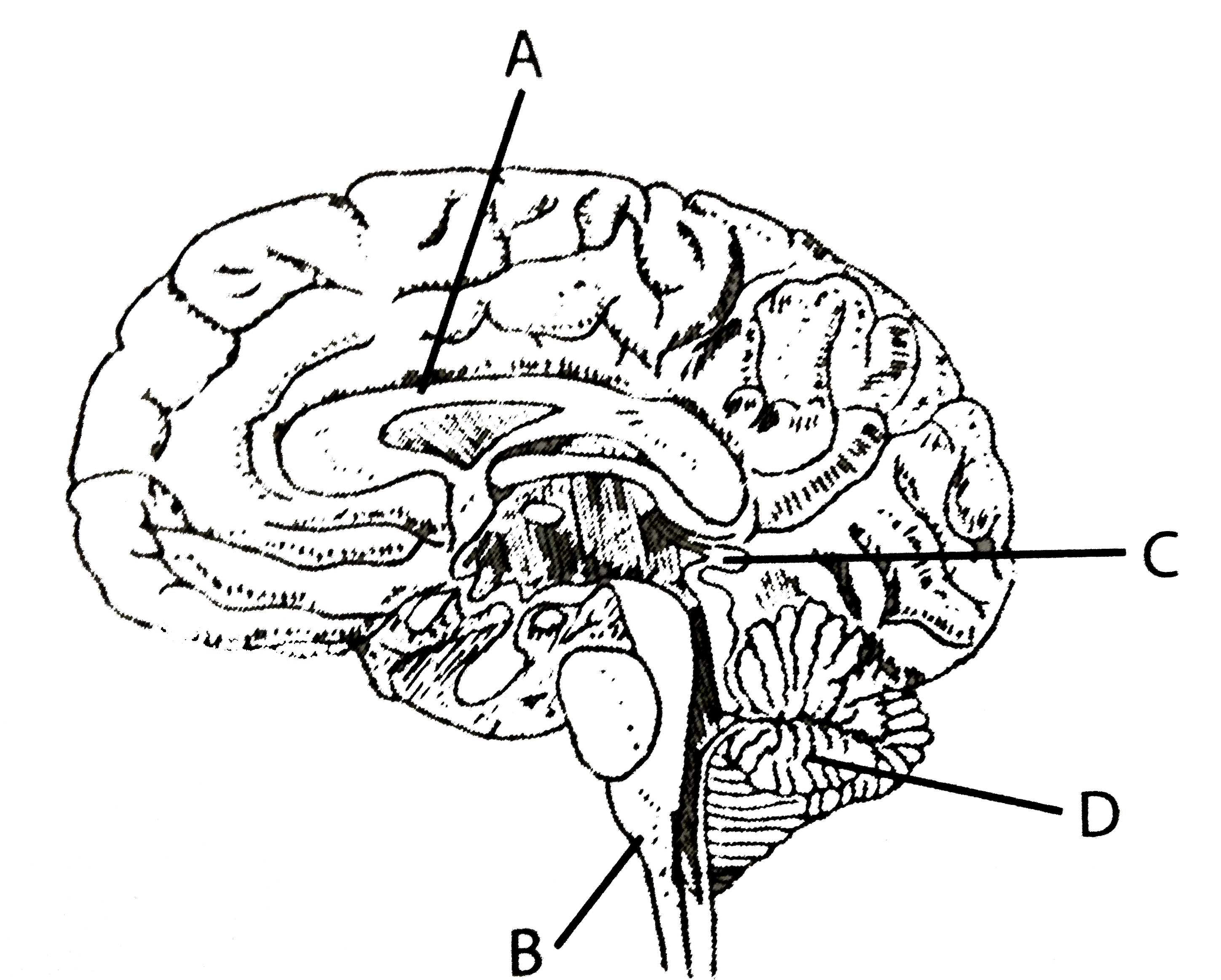 A(A,B,C,D),((ii),(iii),(i),(iv))B(A,B,C,D),((iv),(i),(iii),(ii))C(A,B,C,D),((iii),(ii),(iv),(i))D(A,B,C,D),((i),(iv),(ii),(iii))
A(A,B,C,D),((ii),(iii),(i),(iv))B(A,B,C,D),((iv),(i),(iii),(ii))C(A,B,C,D),((iii),(ii),(iv),(i))D(A,B,C,D),((i),(iv),(ii),(iii)) - Question 3 - Select One
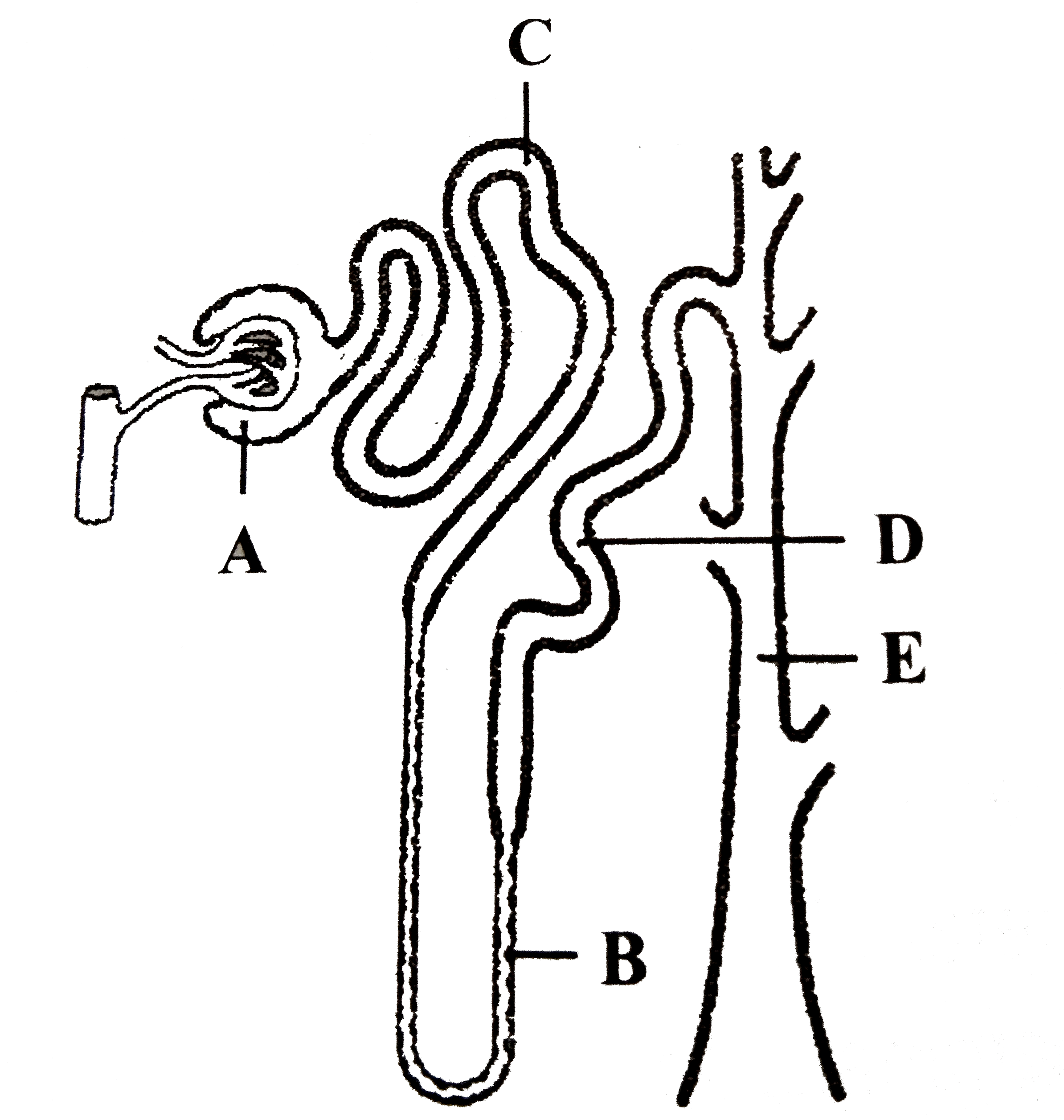
The given figure represents a single nephron from a mammalian kidney. Identify the labelled parts, match them with the functions (i-iv) and select the correct option.
(i). The site of ultrafiltration.
(ii). Particularly sensitive to ADH.
(iii). The main site for the reabsorption of glucose and amino acids.
(iv). Largely responsible for the maintenance of blood pH.A(i)-A,(ii),E,(iii)-C,(iv)-DB(i)-A,(ii)-B,(iii)-C,(iv)-DC(i)-B,(ii)-A,(iii)-C,(iv)-ED(i)-E,(ii)-B,(iii)-D,(iv)-A
The diagram shows the left side view of the male reproductive system. Select the correct option to identify the parts labelled as i, ii, iii and iv.
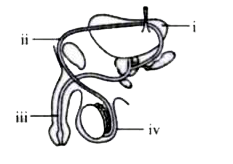 View Solution
View SolutionThe human eye is a complex part of the body that is used for seeing. Eyes enable people to perform daily tasks and to learn about the world that surrounds them. Sight. or vision, is a rapidly occurring process that involves continuous interaction between the eye, the nervous system, and the brain. When someone looks at an object, what he really sees is the light reflected from the object. This reflected light passes through the lens and falls on the retina of the eye. Here the light induces nerve impulses that travel through the optic nerve to the brain and then over other nerves to muscles and glands.
The eye is similar to a television camera. Both the eye and the television camera convert light energy to electrical energy. The eye converts light to nerve impulses that are interpreted by the brain as the sense perception called sight. A television camera converts light to electronic signals that are broadcast and transformed into light images in a television receiver. It is wonderful that human eyes blink an average of once every six seconds. This washes the eye with the salty secretion from the tear or lachrymal glands. Each tear gland is about the size and shape of an almond. These glands are situated behind the upper eyelid at the outer corner of the eye. After passing over the eye, the liquid from the gland is drained into the nose through the tear duct at the inner corner of the eye.
The sense perception that the brain releases after the eye converts light to nerve impulses is known asView SolutionThe human eye is a complex part of the body that is used for seeing. Eyes enable people to perform daily tasks and to learn about the world that surrounds them. Sight. or vision, is a rapidly occurring process that involves continuous interaction between the eye, the nervous system, and the brain. When someone looks at an object, what he really sees is the light reflected from the object. This reflected light passes through the lens and falls on the retina of the eye. Here the light induces nerve impulses that travel through the optic nerve to the brain and then over other nerves to muscles and glands.
The eye is similar to a television camera. Both the eye and the television camera convert light energy to electrical energy. The eye converts light to nerve impulses that are interpreted by the brain as the sense perception called sight. A television camera converts light to electronic signals that are broadcast and transformed into light images in a television receiver. It is wonderful that human eyes blink an average of once every six seconds. This washes the eye with the salty secretion from the tear or lachrymal glands. Each tear gland is about the size and shape of an almond. These glands are situated behind the upper eyelid at the outer corner of the eye. After passing over the eye, the liquid from the gland is drained into the nose through the tear duct at the inner corner of the eye.
The eye is similar to the television camera because bothView SolutionThe human eye is a complex part of the body that is used for seeing. Eyes enable people to perform daily tasks and to learn about the world that surrounds them. Sight. or vision, is a rapidly occurring process that involves continuous interaction between the eye, the nervous system, and the brain. When someone looks at an object, what he really sees is the light reflected from the object. This reflected light passes through the lens and falls on the retina of the eye. Here the light induces nerve impulses that travel through the optic nerve to the brain and then over other nerves to muscles and glands.
The eye is similar to a television camera. Both the eye and the television camera convert light energy to electrical energy. The eye converts light to nerve impulses that are interpreted by the brain as the sense perception called sight. A television camera converts light to electronic signals that are broadcast and transformed into light images in a television receiver. It is wonderful that human eyes blink an average of once every six seconds. This washes the eye with the salty secretion from the tear or lachrymal glands. Each tear gland is about the size and shape of an almond. These glands are situated behind the upper eyelid at the outer corner of the eye. After passing over the eye, the liquid from the gland is drained into the nose through the tear duct at the inner corner of the eye.
The average rate of blinking of an eye isView SolutionThe human eye is a complex part of the body that is used for seeing. Eyes enable people to perform daily tasks and to learn about the world that surrounds them. Sight. or vision, is a rapidly occurring process that involves continuous interaction between the eye, the nervous system, and the brain. When someone looks at an object, what he really sees is the light reflected from the object. This reflected light passes through the lens and falls on the retina of the eye. Here the light induces nerve impulses that travel through the optic nerve to the brain and then over other nerves to muscles and glands.
The eye is similar to a television camera. Both the eye and the television camera convert light energy to electrical energy. The eye converts light to nerve impulses that are interpreted by the brain as the sense perception called sight. A television camera converts light to electronic signals that are broadcast and transformed into light images in a television receiver. It is wonderful that human eyes blink an average of once every six seconds. This washes the eye with the salty secretion from the tear or lachrymal glands. Each tear gland is about the size and shape of an almond. These glands are situated behind the upper eyelid at the outer corner of the eye. After passing over the eye, the liquid from the gland is drained into the nose through the tear duct at the inner corner of the eye.
What do we see when we look at an object?View Solution

